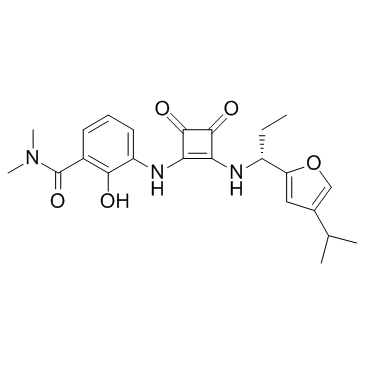473728-58-4
| Name | 3-[[3,4-dioxo-2-[[(1R)-1-(4-propan-2-ylfuran-2-yl)propyl]amino]cyclobuten-1-yl]amino]-2-hydroxy-N,N-dimethylbenzamide |
|---|---|
| Synonyms |
cs-0833
3-[[3-[(dimethylamino)carbonyl]-2-hydroxyphenyl]amino]-4-[[(r)-1-(4-isopropylfuran-2-yl)propyl]amino]cyclobut-3-ene-1,2-dione SCH 563705 |
| Description | SCH 563705 is a potent and orally available CXCR2 and CXCR1 antagonist, with IC50s of 1.3 nM, 7.3 nM and Kis of 1 and 3 nM, respectively. |
|---|---|
| Related Catalog | |
| Target |
CXCR2:1 nM (Ki) CXCR1:3 nM (Ki) CXCR2:1.3 nM (IC50) CXCR1:7.3 nM (IC50) Mouse CXCR2:5.2 nM (IC50) |
| In Vitro | SCH 563705 (Compound 16) is a potent and orally available CXCR2 and CXCR1 antagonist, with IC50s of 1.3 nM, 7.3 nM and Kis of 1 and 3 nM, respectively. SCH 563705 shows potent inhibition against both Gro-a and IL-8 induced human neutrophil migration (chemotaxis IC50 = 0.5 nM, against 30 nM of Gro-a; chemotaxis IC50 = 37 nM, against 3 nM of IL-8)[1]. SCH 563705 potently inhibits mouse CXCR2 (IC50 = 5.2 nM)[2]. |
| In Vivo | SCH 563705 has good oral pharmacokinetic profiles in rats, mice, monkeys and dogs[1]. SCH 563705 (50 mg/kg p.o) reduces blood Ly6G+ Ly6C+ neutrophil frequency and unchanged levels of Ly6GLy6Chi monocytes. SCH563705 (3-30 mg/kg p.o) treatment causes a dosedependent elevation in plasma levels of CXCL1[2]. |
| Animal Admin | Mice[2] Induction of anti-collagen antibody-induced arthritis. Anti-collagen antibody-induced arthritis (ABIA) is induced in BALB/c mice (n = 8 mice per treatment group) as follows. On day 0, mice are injected intraperitoneally with 4 mg ArthritoMAB Arthritis-inducing Antibody Cocktail. On day 3, mice are boosted intraperitoneally with 50 μg of lipopolysaccharide from Escherichia coli 055:B5 in 200 μL sterile PBS. In all studies, SCH 563705 is administered in a vehicle consisting of 0.4% METHOCEL E15 premium hydroxypropyl methylcellulose (MC). Clinical scores are determined daily as follows. Each paw is assigned a score of 0-4 based on the following criteria: asymptomatic, 0; slight redness, 1; one or more swollen digits in addition to redness, 2; swelling of entire paw, 3; ankylosing of joints and residing of swelling, 4. The sum of the four paw scores for each mouse (0-16) are plotted against time to calculate the area under the curve (AUC) of disease activity. Paw hickness measurements are made daily using a micrometer caliper over the metatarsals of the paw. The percent change in paw thickness relative to baseline (day 0) measurements is then calculated[2]. |
| References |
| Density | 1.29g/cm3 |
|---|---|
| Boiling Point | 555.9ºC at 760 mmHg |
| Molecular Formula | C23H27N3O5 |
| Molecular Weight | 425.47800 |
| Flash Point | 290ºC |
| Exact Mass | 425.19500 |
| PSA | 111.88000 |
| LogP | 3.79050 |
| Index of Refraction | 1.615 |
| Storage condition | 2-8℃ |
